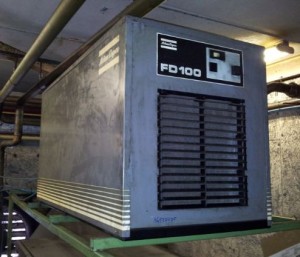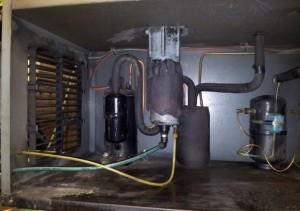Get a low-cost way to remove water from compressed air, by installing a refrigerated compressed air dryer and avoid condensate problems.
A refrigerated compressed air dryer is a type of compressed air dryer, used to dry compressed air.
Compressed air always contains water, coming from the air that is sucked in by the compressor.
To protect your piping, tools and equipment, it's best to use a compressed air dryer to dry the air.
Why a refrigerated compressed air dryer?

Refrigerated air dryer
Refrigerated compressed air dryers are one of the most common used types of air dryers (for other types, check out our general page on compressed air dryers). They are simple in design, need very little maintenance and are relatively cheap.
A refrigerated compressed air dryer is the standard choice if you're shopping for a dryer and don't have special requirements, like an ultra-low dewpoint. T
hey don't need much or any special maintenance and
if you buy a quality one, and install it properly, it's basically set-and-forget.
How does it work?
As the name implies, a refrigerated air dryer works by cooling down the air (like a refrigerator).
The warm wet air enters the dryer, where it is cooled down to about 3 degrees Celsius. All water vapor that was in the air condenses into water.
Much like your window does on a cold day. The liquid water is then removed from the compressed air by a water-trap.
After that, the cold air is re-heated to room temperature. Since a lot of water has condensed into water, the air is now much dryer.
The cooling is done in the same way as your freezer and fridge are cooled. In a separate circuit, liquid refrigerant is evaporated in the evaporator, to cool down the warm compressed air.
The air is cooled, while the refrigerant gets warmer. The refrigerant is compressed by a small compressor and cooled again in the condenser.
Here are two pictures of the inside of an old refrigerated compressed air dryer. You can see the various parts of the refrigerant circuit (with refrigerant compressor and condenser). You can also see the condensate trap with discharge lines.
The evaporator (where the refrigerant cools down the compressed air) is located at the top of the dryer (the whole area at the top is the insulated evaporator).
In the background you see the refrigerant circuit of a compressed air dryer. In the middle is the condensate trap (with water discharge lines).
At the right the condenser with cooling fan. In the middle you see the refrigerant pipes that go to the evaporator. At the left the condensate trap again.
Types of refrigerated compressed air dryers
There are basically two types of refrigerated compressed air dryers. Cycling and non-cycling. The advantage of the cycling dryer is that it will increase or decrease cooling capacity according to air use. This reduces the energy used and saves you money.
The non-cycling is the most common type and is extremely reliable and have the lowest maintenance
costs.

Example of a refrigerated compressed air dryer. This one is installed after a rotary screw compressor (Atlas Copco GA37, 37 kW compressor). On the control panel you see a start/stop button and the dew-point indicator.
What to look for when buying one?
There are a few key points to keep in mind when shopping for a refrigerated compressed air dryer.
- The maximum pressure. The maximum pressure of the dryer must be the same, or higher than that of your compressor.
- Maximum flow. The maximum air flow that can flow through your dryer (in liters/sec or cfpm) must be higher than what your compressor can deliver.If you choose a too small air dryer, it will result in a big pressure-drop over your dryer (because the air has trouble passing through it). Because of this, you need to set your compressors pressure higher to compensate for the pressure drop. This again will result in a higher energy bill.Secondly, your dryer might not be able to reach the desired dew point.
- Inlet temperature. Air dryers have a maximum specified inlet temperature. If this temperature is exceeded, you can either damage parts of the dryer, or the dryer just doesn't have enough capacity to reach the desired dewpoint.Some compressors have an after-cooler installed, in which case the compressed air will be around
40 degrees Celsius. Without an after-cooler, the air will be around 80 degrees Celsius or higher!Check the temperature of the compressed air leaving your compressor. Is it very hot? There are special 'high inlet temperature' dryers on the market, which are specifically designed to be able to work with your hot air. - Maximum outside (room) temperature. Will you put your dryer in a hot room? Chances are that the dryer will over-heat and shut itself down. Find out what the maximum temperature is (in summer) in your compressor room and buy a dryer that can handle that.
Maintenance and installation
Always check the manual for guidelines on the installation and maintenance of your refrigerated compressed air dryer. Every make and type has its own specific needs and instructions.
In general however, keep the following things in mind:
Install the dryer in a cool, dust-free room. You will probably also need a drain somewhere to get rid of the water (can be liters of water per day!). Normally you just need a standard 115 (usa) / 230 (Europe) voltage power source.
By far the most common, number 1, breakdown I have seen with compressed air dryer is over-heating. When the condenser of the refrigerant circuits get dirty, or the room is just too hot, the dryer can't get rid of the heat. It will eventually trip on its over-pressure switch.
Maintenance: clean the condenser once in a while. Be careful, the small plates (fins) are sensitive. A good way to remove all the dust is by using a steel-brush and gently scrape off all the dust. There are also special condenser fin combs to clean and straighten the fins.
Another problem I have seen sometimes is that the dryer actually gets too cold!
If for some reason the dryer dries the air to below 0 degrees Celsius, the water will freeze and the ice will block the pipes. In the end, the dryer will be completely blocked.
Sometimes this happens because somebody just set the setpoint too low, sometimes there is something wrong in the refrigerant circuit (a sensor or valve for example), in which case you will need to get a mechanic to repair it.


